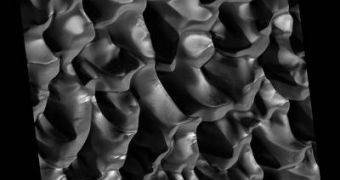The Mars Reconnaissance Orbiter (MRO) is, at this point, the NASA spacecraft that has returned the highest amount of scientific data of all missions to the Red Planet. The volume of information engineers back on Earth received since November 2006 can now fill about 1,000 CDs, and is on par with the amount of data beamed back between 1997 and 2006 by the Mars Global Surveyor mission. But mission controllers are currently worried about the fact that two of the craft's instruments are intermittently turned on and off, a fact that prevents them from sending data at full capacity.
A worsening problem on MRO was discovered in late November 2006, shortly after the beginning of the primary science phase. In one of the 14 camera detector pairs that make up the High Resolution Imaging Science Experiment, engineers noticed an increase in noise. This meant that bad pixels occurred in one of the detectors. The glitch had only a small influence on the overall quality of the image. To top things, last month, experts discovered that five other detectors were developing a similar problem.
NASA experts are in the dark as to what precisely is causing this degeneration in the instruments' health, but they noticed that, by warming the cameras more before snapping photos, the bad pixels were reduced in number. However, despite knowing this, they have not identified the underlying cause of this problem as of yet, which means that they don't have any way of addressing it in the long run, a press release by the NASA-owned Jet Propulsion Laboratory, in Pasadena, California, says.
The Mars Climate Sounder is the second instrument on the spacecraft that is acting up. It was designed specifically for analyzing the Martian atmosphere from the ground up, as in above the horizon line. The device maps the temperature, ice clouds and dust distributions in the planet's atmosphere at each of its daily 13 orbits. Last December, the team at NASA noticed that the MCS seemed to simply “skip” some steps in its observation procedure, which caused the images to appear slightly off.
This problem was eventually solved, as engineers uplinked a new set of scan tables on the MRO, which seemed to make the instrument's glitches stop. Still, in January 2009, the issues reappeared, to everyone's puzzlement. The problem became increasingly frequent with time, so the mission managers decided it would be best if the MCS was temporarily stopped, until experts would get a chance to understand what exactly was wrong with it.

 14 DAY TRIAL //
14 DAY TRIAL //